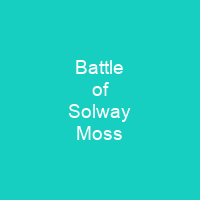The Battle of Solway Moss took place on the English side of the Anglo-Scottish border in November 1542. King James V had refused to break from the Catholic Church, as urged by his uncle King Henry VIII. The Scottish army that marched against them was poorly led and organised. Many Scots were either captured or drowned in the river.
About Battle of Solway Moss in brief

Gervase Phillips has estimated that only about seven Englishmen and 20 Scots were killed but 1,200 Scottish prisoners were taken. Prisoners taken to England included Lord Gray, and Stewart of Rosyth. A number of captured Scottish earls, lords, and lairds were released; they sent hostages, called ‘pledges’, into England in their place. E. Chapuys reported that the Scottish prisoners attended Henry’s court on Christmas Day wearing swords and dirks.
You want to know more about Battle of Solway Moss?
This page is based on the article Battle of Solway Moss published in Wikipedia (as of Dec. 09, 2020) and was automatically summarized using artificial intelligence.







